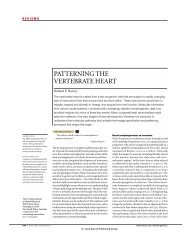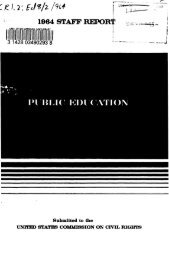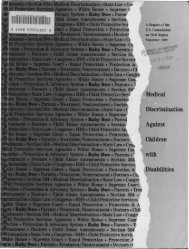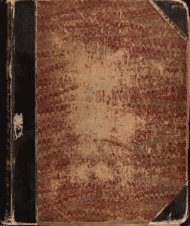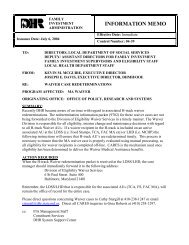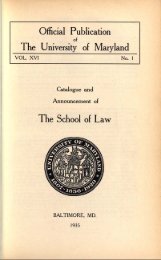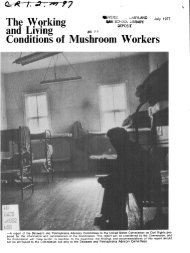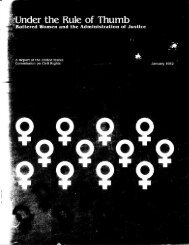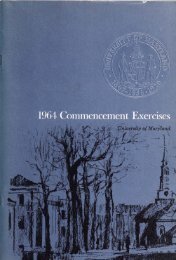1961 US Commission on Civil Rights Report Book 2 - University of ...
1961 US Commission on Civil Rights Report Book 2 - University of ...
1961 US Commission on Civil Rights Report Book 2 - University of ...
Create successful ePaper yourself
Turn your PDF publications into a flip-book with our unique Google optimized e-Paper software.
Notes: Educati<strong>on</strong>, Chapter 6—C<strong>on</strong>tinued<br />
120. By way <strong>of</strong> analogy to the tuiti<strong>on</strong> grant systems, it is interesting to<br />
note that in the Enoch Pratt case not <strong>on</strong>ly did the library receive<br />
direct financial aid from the city, but its employees were <strong>on</strong> the city<br />
pay scale, and bel<strong>on</strong>ged to the municipal retirement system.<br />
Additi<strong>on</strong>ally the city c<strong>on</strong>trolled the library's budget and owned the<br />
library plant valued at over $4 milli<strong>on</strong>.<br />
121. In another case decided in 1958 by the Court <strong>of</strong> Appeals for the<br />
4th Circuit in Eat<strong>on</strong> v. Board <strong>of</strong> Managers <strong>of</strong> the James Walker<br />
Memorial Hospital, 164 F. Supp. 191 (1958), aff'd, 261 F. ad 521<br />
(4th Cir. 1958), cert, denied, 359 U.S. 984 (1959), the questi<strong>on</strong><br />
was whether the plaintiffs, three Negro doctors, were denied equal<br />
protecti<strong>on</strong> by the defendant hospital by exclusi<strong>on</strong> from staff<br />
privileges because <strong>of</strong> their race. The issue, in substance, was<br />
whether or not the hospital was an instrumentality <strong>of</strong> the State.<br />
It had been established in 1881 and supported and operated until<br />
1901 by municipal authorities. The court had no hesitati<strong>on</strong> in<br />
describing it as a State agency up to that date. In 1901, however,<br />
a private corporati<strong>on</strong> was organized. The city and county <strong>of</strong><br />
Wilmingt<strong>on</strong>, N.C., c<strong>on</strong>veyed the land <strong>on</strong> which the old hospital<br />
stood to the new corporati<strong>on</strong>. The latter erected a new building<br />
<strong>on</strong> the site with c<strong>on</strong>tributi<strong>on</strong>s from private d<strong>on</strong>ors. For 50 years<br />
thereafter the hospital received financial support from local appropriati<strong>on</strong>s<br />
in unspecified amounts with the approval <strong>of</strong> the State<br />
legislature. In 1951 the Supreme Court <strong>of</strong> North Carolina found<br />
such financing unc<strong>on</strong>stituti<strong>on</strong>al <strong>on</strong> the ground that the support <strong>of</strong><br />
a hospital was not a necessary government expense. The local<br />
governments then entered into c<strong>on</strong>tract with the hospital for<br />
the care <strong>of</strong> indigent patients. The total payments received<br />
under the c<strong>on</strong>tract in 1957 when the suit was brought were<br />
about 5 percent <strong>of</strong> the hospital's gross income. The Federal district<br />
court dismissed the suit <strong>on</strong> the ground that the discriminati<strong>on</strong>,<br />
if any, was by a private instituti<strong>on</strong> so that no I4th amendment<br />
questi<strong>on</strong> was involved. The court <strong>of</strong> appeals affirmed, finding<br />
insufficient financial support by local governments to c<strong>on</strong>stitute<br />
"State acti<strong>on</strong>." The <strong>on</strong>ly links between the State and the hospital<br />
were the payments under c<strong>on</strong>tract for the care <strong>of</strong> indigent<br />
patients and a right <strong>of</strong> reverter in <strong>on</strong>e-half <strong>of</strong> the hospital's land<br />
if it ceased being used for hospital purposes.<br />
As to the period 190 i-i 951 the Court <strong>of</strong> Appeals said :<br />
216<br />
In 1901 . . . a new building was erected <strong>on</strong> the site with funds<br />
provided by the benefactor. It would seem from the evidence<br />
that the hospital then ceased to be a public agency, although in<br />
the subsequent years until 1951 it received certain financial




